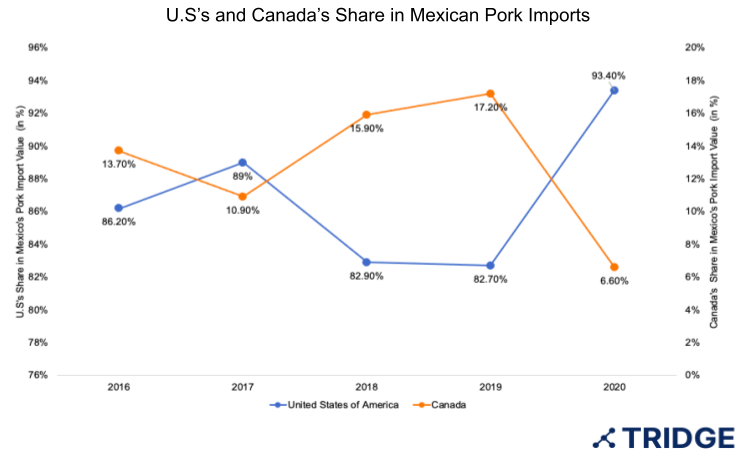U.S. Pork Exports to Mexico Pick Up Pace in 2022

Mexico imported pork worth USD 1.30 billion in 2020, making it the third-largest pork importer in the world. It relies on the United States (U.S.) Canada and Chile for pork imports to meet its domestic demand. Mexico happens to be the third-largest market for pork for the U.S. as it had a 15.4% share in the U.S’s pork exports and exported meat worth USD 921 million. In March 2018, the U.S imposed tariffs on steel and aluminum from Mexico on the grounds of national security. Mexico retaliated by imposing tariffs on a variety of agricultural products – including pork which reduced the value of American pork imports in the country. Starting in June 2018, U.S. pork exporters faced a 10% tariff in one of their most important markets. Which was later increased to 20% in July 2018.
Even though the U.S. was exporting pork to Mexico, it lost the benefits associated with the North American Free Trade Agreement and a large share of the market in Mexico. Immediately after the imposition of retaliatory tariffs in 2018, U.S. pork exports to Mexico dropped to below year-earlier levels and remained subdued during the rest of the year. From January through May of 2018, U.S. shipments to Mexico were running 7% higher than in 2017; however, they ended the year 2% lower in the face of the tariff-rate disadvantage. In 2017, the U.S. had a share of nearly 89% in Mexico’s total imported pork market which fell to 82.9% in 2019 as a result of the tariffs. During this period Canada became the primary beneficiary and captured the market in Mexico. In 2017, Canadian pork had a share of only 10.90% in Mexico’s imports which surged to 15.90% in 2018 and a further 17.20% in 2019.

Source: ITC TradeMap. HS Code: 0203 Meat of swine, fresh, chilled, or frozen.
In May 2019, the U.S. withdrew the 232 tariffs levied on Mexican steel and aluminum, following which Mexico also removed the retaliatory tariffs on U.S. pork. After this, pork shipments to Mexico had shown some recovery but remained largely below the levels seen in 2017 – prior to the trade dispute. Strong signs of recovery were seen at the start of 2020 but were subdued due to a weak Mexican economy and COVID-19 pandemic creating new challenges for the pork trade. As the pandemic settled and the COVID-19 cases were under control, the demand started picking up again in 2021 and the U.S.'s pork exports started showing signs of improvement. Throughout September 2021, U.S. pork exports to Mexico increased by 30 percent over the same period in 2020.
By the second quarter of 2021, Mexico again became the top international destination for U.S. pork as shipments reached a record high in August and again in September. The pork shipments from the U.S. are expected to improve further next year as things get back to normal. Pork producers in the U.S. are looking forward to returning trade to the levels seen before the disruptions of the last two years. It is expected that the Mexican pork import demand will be very strong in 2022 and will push U.S. pork exports to record levels and capitalize on the opportunity. Both countries benefit from geographic proximity and existing trade linkages which create a comfortable environment for them to engage in tariff-free trade and reap benefits out of it.
Sources
- Farm Policy News. “China’s Soy Imports Slump in October, as “U.S. Pork Exports to Mexico Show Promise”.
- ITC TradeMap. HS Code: 0203 Meat of swine, fresh, chilled, or frozen.
- NBC News. “Mexico will impose 20 percent tariffs on U.S. pork.”
- USDA. “After Several Difficult Years, U.S. Pork Exports to Mexico Show Promise.”